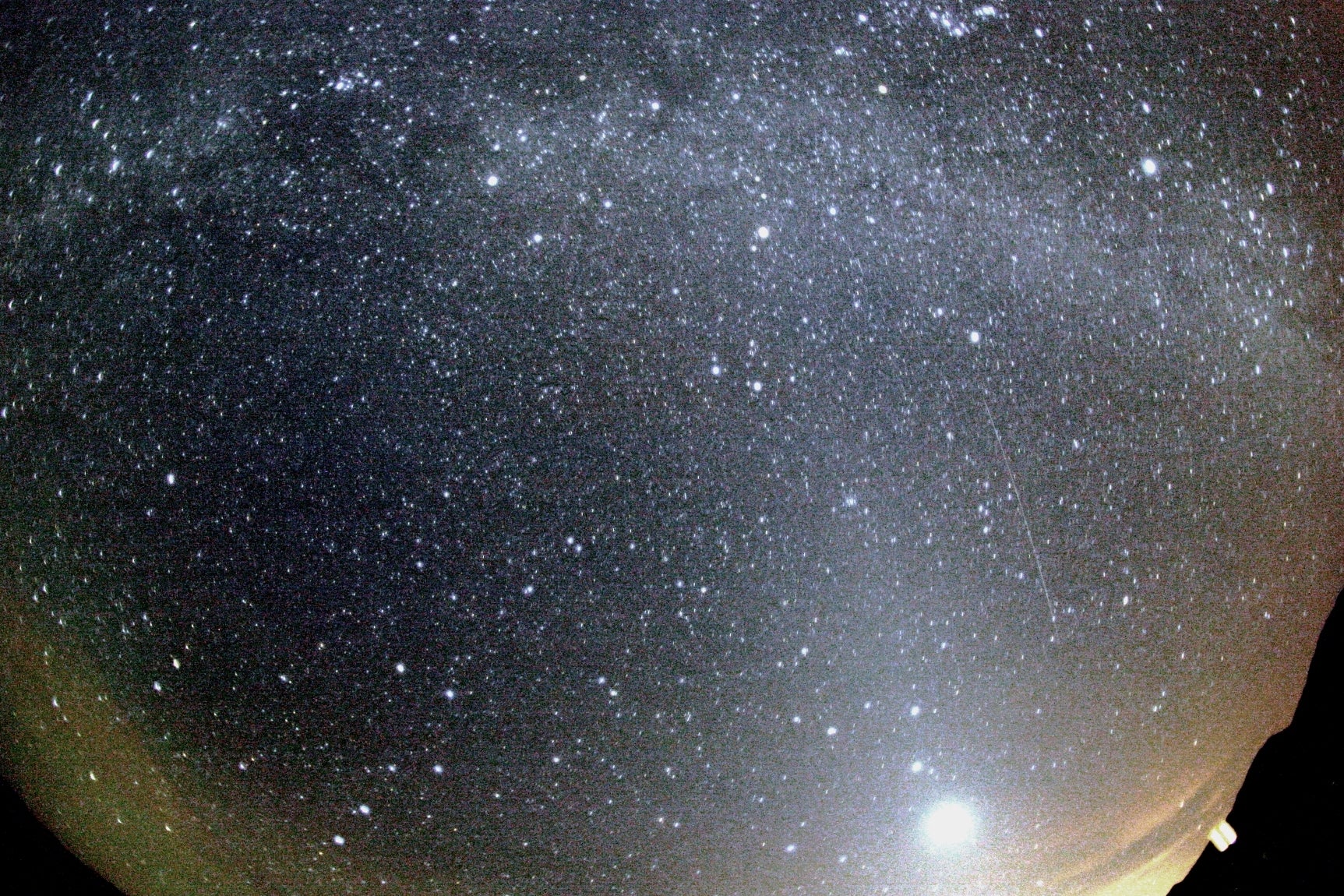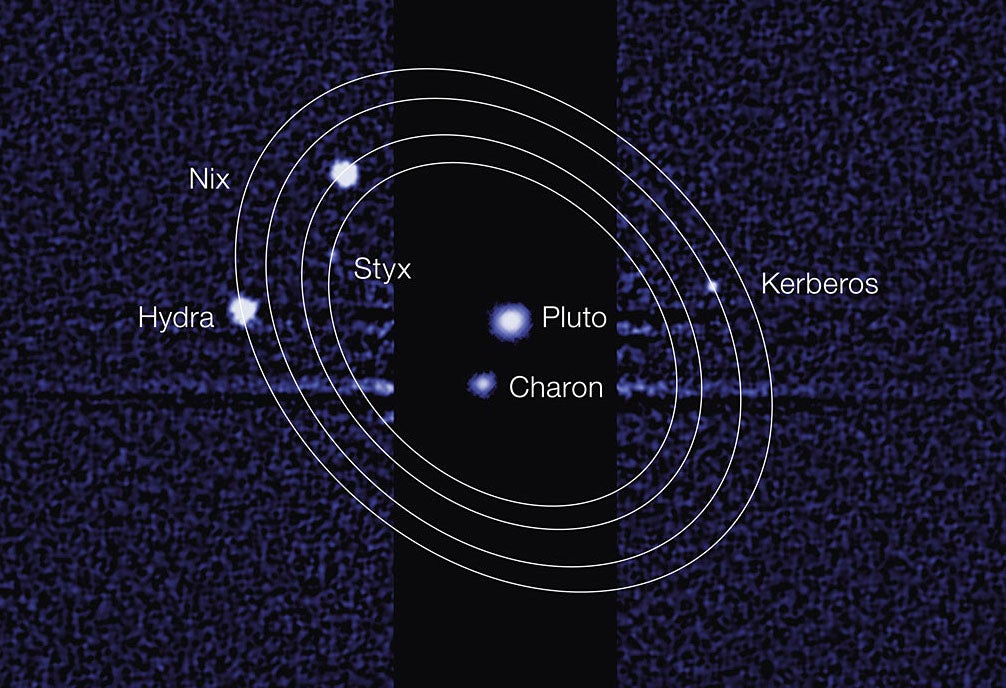Sprinkle, shower or storm?
Orionid meteor shower tonight — Let’s talk meteor showers for a minute. Majors, minors, what to expect, when to view. Storm vs shower. The world began tomorrow in 4004 BC according to Bishop Ussher who used Bible generation counting method to determine when the world began. Clocks change this coming Sunday in Europe, but the U.S. waits an extra week to fall-back. First we’re told that Pluto has a moon, then we’re told it isn’t a planet, now we discover it has at least FIVE moons and their weird orbits are the result of a gigantic collision that took place some 4 billion years ago. Pretty complicated stuff for being a dwarf planet, huh?
October 21, 2013
[Dave Heller] Let’s prepare for the Orionid meteor shower tonight with Derrick Pitts, chief astronomer at the Franklin Institute. Derrick, these showers seem to come more and more frequently. Where does this one rank in the pantheons of Persieds and Geminids?
[Derrick Pitts] I would say actually that the Orionid meteor shower is the next tier down from these. Doesn’t show as many as a hundred meteors per hour, really it’s about the 30-50 meteor per hour range, in there, if conditions are good. However, it still is one that if you have good clear dark skies and nothing else to do, you might go out and see if you can catch a little bit of it. Of course the name Orionid indicates that the meteors seem to emanate from a point in the constellation Orion, so that gives you an idea of where you could look in the evening sky if you wanted to see the radiant point, as it’s called. A standard background rate for meteors seen in any sky is about 10 per hour. We get to the 30 category, then we might say we’re seeing a meteor shower, or anywhere above that. If we’re into the hundreds per hour or thousands per hour, then we talk about a meteor storm. However, we tend to see meteor showers far more frequently than we see meteor storms. So the Orionid ranks as a meteor shower of, I would say, the second tier, behind the Persied shower and the Geminid shower.
-

Orionid meteor shower. Photo credit: Wikipedia
It turns out that Europe is falling back this Sunday; we’re waiting an additional week before we change our clocks.
Yes, we are waiting an additional week. And you know, the reason why the Europeans are ahead of us in this particular case is because Congress here in the U.S. has been sort of fiddling around when the change-over date is from daylight savings time to eastern standard time, or to standard time, I should say. And the reason why they’ve been fiddling around with it is they’re trying to determine whether or not it’s more energy efficient for us to move these times around so that we can work with more or less sunlight at various times of the year in an effort to save energy. Now this is something that was put into place a few years ago now, and this period is the test period when we’re supposedly determining whether or not shifting the times around is actually saving us energy.
But again, this test is merely fine-tuning in terms of energy savings. It’s clear that there are advantages to having a daylight savings time season.
Oh, absolutely. Absolutely there are advantages. Although some places around the world don’t make the change at all.
Some places in the world think that the world began 4000 years ago, more or less.
[Laughs] Yes, we’re coming up on the anniversary of a determination made by an Irish bishop of the Irish Catholic church, Bishop Ussher. Now this work was done by Bishop Ussher in the 17th century; and what Bishop Ussher did was, he looked at the Bible and he used generations of people in the Bible to count back when the Earth should have begun according to how people were begat according to the Bible! So what he came up with was a date in October that was in the year 4004 B.C.
Were there adherence of Usher’s arithmetic in his day?
At that time, of course, the story was what the church says and what the Bible says is what actually happened. And we all know that Galileo got into great trouble around about the similar time trying to get the Italian church to realize that the solar system is really structured with the sun at the center with planets orbiting around, and that the Earth was not at the center of the solar system.
Course there’s another aspect of the solar system that keeps coming under revision, and that’s the status of tiny Pluto.
You know, first we started out with Pluto as being a planet of our solar system, the very last one. Then we realized that Pluto actually has a moon! Wow, how exciting! Well then we realized, hey wait a minute, Pluto actually shouldn’t be a planet of our solar system because of its original history. But now we’ve discovered that it has four more moons than we originally expected. So where does this place Pluto as a real planet? It is spherical, it is in orbit around the sun, for the most part it has cleared its orbit of all sorts of other debris, but it does have five moons. Well, wouldn’t that make it a planet?
Yes.
I would say yes too. And as I always say, the Plutonians really don’t care what we think because they still think of themselves as a planet. But we have reclassified it as a dwarf planet. What’s really interesting nowadays is though is as we look at the moons orbiting Pluto, the larger moon Charon is closer to pluto and the smaller ones are outside. And this tells us that the dynamics of how that planetary system was built was very much different from what we would expect to be the way that this planetary system would be built.
Though on balance you’ve made such a compelling case for Pluto being included as a planet. Remind us again what the counter argument is.
The counter argument is that Pluto wasn’t actually an original member of the solar system. The larger planets of the solar system — the gas giants Jupiter, Saturn, Uranus and Neptune — exerting their gravitational force on other debris flying around the solar system actually captured Pluto as a passing body and pulled it into an orbit that then was centered around the sun. If we look at the orbit of Pluto, we find that its orbital path is tilted 18 degrees away from the orbital plane of the solar system. So that’s an indication right there that something very odd happened in the early history of our solar system, but after the other planets had fallen into their orbits around the sun.
One thing beyond dispute — this all happened 4004 years ago.
[Laughs] And then some on top of that …
WHYY is your source for fact-based, in-depth journalism and information. As a nonprofit organization, we rely on financial support from readers like you. Please give today.






